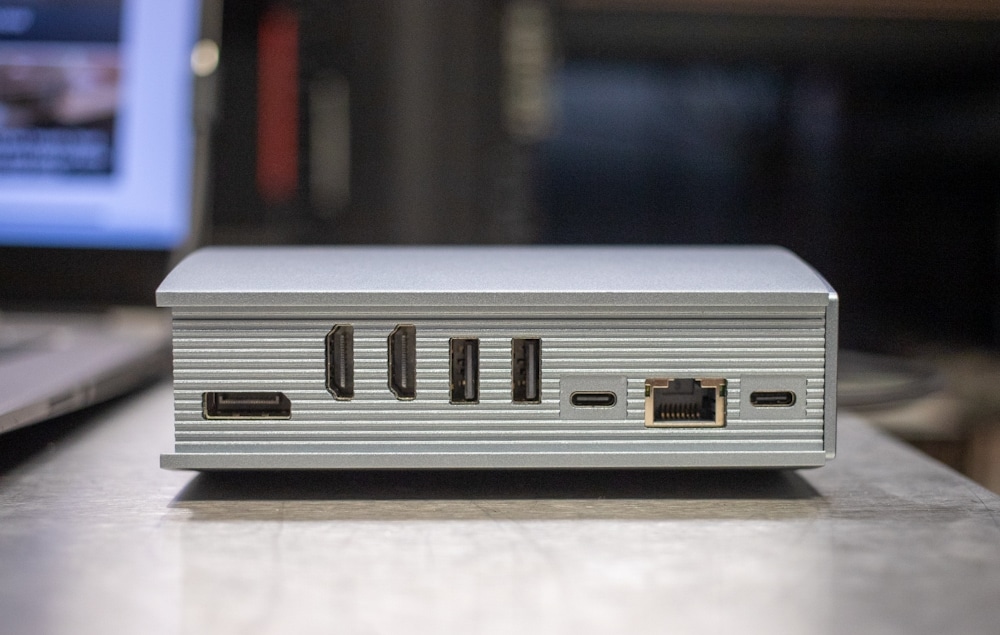The ORICO USB Type-C docking station is a multi-purpose solution that offers a wide range of connectivity. Built around a USB interface instead of Thunderbolt, it has broad compatibility but without DisplayPort pass through. This makes it ideal for general users looking to extend the functionality of notebooks and for content professionals who need to do light editing on larger 4K screens.
The ORICO USB Type-C docking station is a multi-purpose solution that offers a wide range of connectivity. This makes it ideal for general users looking to extend the functionality of notebooks and for content professionals who need to do light editing on larger 4K screens.

Connectivity-wise, the docking station features seven USB ports: two USB-A 3.0, four USB-A 2.0, and one USB-C 3.0. It also includes a DP 1.4 port, two HDMI ports, one RJ45 LAN Gigabit Ethernet port, an SD/TF card reader slot, and an audio in/out port. The wide selection of ports helps to supplement what a user might need to connect to their primary device. For many though it will replace all notebook ports, allowing a single connection to charge the device and drive the monitor and accessories.
It also features 100W in power delivery via the USB-C ports on the back, which means you can charge smaller devices like Apple or Android mobile devices. While it will have no problem charging tablets and phones, larger devices like MacBooks (which are specced around 87/96W) should be using it as a hub to charge them.
ORICO claims that users can connect up to two external monitors to the ORICO docking station via the HDMI ports for full a 4K@30Hz. For those who want a three-monitor setup, users can use the host laptop and two connected monitors in extended mode. Users that go this route will run into some limitations.
Thunderbolt-based docks natively pass monitor DisplayPort/HDMI signals, which means anything you can do on the host laptop display you can do on an output display connected to the dock (including gaming). However, this is a USB-C-based docking station that leverages the DisplayLink driver for USB-based monitor outputs.
This gives it an advantage for driving more screens with a wide range of devices supporting it but limits certain performance attributes. While 4K signals certainly do work with the ORICO device, it is only really ideal for things like productivity and web browsing. Once you move on to more intensive activities like watching YouTube 4k videos, it gets choppy and unstable.
Backed by a 1-year limited warranty, the ORICO USB Type-C Docking Station goes for roughly $150 at Amazon.
ORICO Type-C Multifunctional Docking Station Specifications
| Model | ORICO-CDH-15N |
| Material | Aluminium Alloy |
| Color | Gray |
| Size | 146mm(L) x 107.1mm(W) x 47.5mm(H) |
| Connectivity |
|
| Theoretical Transmission Rate | Up to 40Gbps |
| Resolution Ratio | Support 5K or Dual 4K Displays:
Single monitor: 5K (5120 x 2880 @ 60Hz)& Dual monitor: 4K (3840 x 2160 @ 60 Hz) |
| Power supply | 20V/3.25A 60W (max) |
| System Supported | MacOS 10.12 or later / Windows 8, 8.1, 10 or later |
ORICO USB-C Multi-Purpose Docking Station Design and Build
Docking stations and connectivity hubs come in all different sizes depending on your needs. The ORICO device measures 5.21 inches (height) x 4.21 inches (length) x 1.87 inches (width), making it one of the medium-sized models. However, that is simply due to how many ports and power this device offers.
The left side of the all-aluminum ORICO docking station is home to the status indicator light, the usual 3.5mm audio jack, an USB Type-C port (5Gbps), two USB-A 3.0 ports (5Gbps), two USB-A 2.0 ports (480Mbps), and the SD/TF slots (note these can’t be used concurrently to read data).
On the other side are the DP 1.4 port, two HDMI ports, dual USB-A 2.0 ports, the USB-C 3.0 (this is the port you use to connect to another computer), an RJ45 network port, and the 100W Type-C charging port.
As you can see, ORICO did not label any of the output ports on the docking station (e.g., which Type-C port is used for laptop input), meaning users will have to refer to the product manual or website to know which ports are which. This is very unfortunate, as this can be a lot of connectivity for users to deal with and can get confusing fast.
Conclusion
Depending on your needs, the 15-1 ORICO USB-C docking station can be a very useful device, expanding on the connectivity and functionality of a laptop. It offers a wide range of connectivity, including seven USB ports of all types and speeds (though nothing beyond 5Gbps), and has the ability to power mobile devices via its 100W PD port. We also really liked the all-aluminum, premium-feeling build.
The important advantage of the ORICO USB-C docking station is the availability of video outputs, which include two HDMI ports and one DisplayPort 1.4. While most notebooks can’t pass more than two 4K outputs over a Thunderbolt connection, this dock uses an emulated video card, so users will be able to get more productivity-grade displays to use from it.
That said, there are some limitations you definitely should keep in mind before purchasing this docking station. While ORICO indicates you can set up a dual-4K display experience (and it does work), you should only do things like non-intensive activities with your connected laptop. Anything beyond that will affect the monitor performance significantly (instability, choppiness etc.), which is certainly significant to content creators.
But if all you want to do web browse the web, use productivity applications, and do some very light video editing, then the ORICO Type-C Multifunctional Docking Station Specifications might be for you. However, those looking for a solution with native video output for use cases like professional applications and gaming should look into ORICO’s Thunderbolt 3 model.
Engage with StorageReview
Newsletter | YouTube | Podcast iTunes/Spotify | Instagram | Twitter | Facebook | TikTok | RSS Feed



